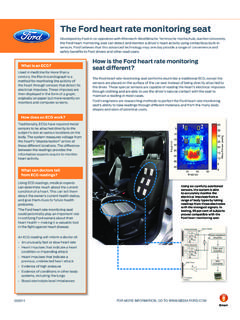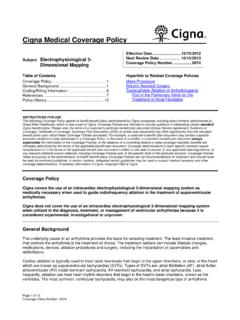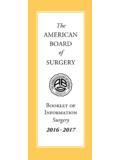Transcription of FOR THE NORTHERN DISTRICT OF ILLINOIS SADHISH K. SIVA ...
1 Case: 1:19-cv-01407 Document #: 1 Filed: 02/26/19 Page 1 of 30 PageID #:1. IN THE UNITED STATES DISTRICT COURT. FOR THE NORTHERN DISTRICT OF ILLINOIS . SADHISH K. SIVA, ). ). Plaintiff, ). ). v. ) No. 1:19-cv-01407. ). AMERICAN BOARD OF RADIOLOGY, ). ) CLASS ACTION. ) Trial by Jury Demanded Defendant. ). CLASS ACTION COMPLAINT. Plaintiff SADHISH K. Siva, ( Plaintiff ), for his Complaint against Defendant American Board of Radiology ( ABR or Defendant ) hereby alleges as follows: INTRODUCTION. 1. This case is about ABR's illegal and anti-competitive conduct in the market for initial board certification of radiology physicians ( radiologists ) and the market for maintenance of certification of radiologists. In very general terms, a radiologist identifies and assesses abnormalities in imaging studies such as X-rays, computer tomography (CT) scans, and magnetic resonance imaging (MRI) scans.
2 ABR is illegally tying its initial certification product to its maintenance of certification product, referred to by ABR as MOC. 2. This case is also about ABR's illegal creation and maintenance of its monopoly power in the market for maintenance of certification. ABR is the monopoly supplier of initial certifications for radiologists. Beginning in or about 1994, ABR used its monopoly position in the initial certification market to create a monopoly in the market of maintenance of certifications for radiologists, which is the subject of this lawsuit. Since then ABR has used various anti-competitive, exclusionary, and unlawful actions to promote MOC and prevent and Case: 1:19-cv-01407 Document #: 1 Filed: 02/26/19 Page 2 of 30 PageID #:2. limit the growth of competition from new providers of maintenance of certification for radiologists. ABR's conduct, including but not limited to tying and exclusive dealing, has harmed competition by preventing competition from others providing cheaper, less burdensome, and more innovative forms of maintenance of certification desired by radiologists.
3 3. The tying product is ABR's initial board certification, which it sells to radiologists nationwide. ABR currently sells initial certification services to radiologists in four primary areas of radiology, diagnostic radiology, radiation oncology, medical physics, and interventional radiology/diagnostic radiology, and several subspecialties within the field of radiology. Many radiologists hold multiple initial ABR certifications , purchasing one or more primary certifications or subspecialties. 4. The tied product is MOC, ABR's maintenance of certification. ABR has tied MOC to its initial certification. As described more fully below, to drive sales of MOC and to monopolize the market for maintenance of certification, ABR has forced radiologists to purchase MOC, charged supracompetitive monopoly prices for MOC, and thwarted competition in the market for maintenance of certification.
4 5. Currently, approximately 1,500-2,000 radiologists in the United States purchase ABR primary initial certifications annually. ABR has throughout the relevant period controlled the market for initial certification of radiologists in the United States. 6. In 2016, the last year for which data is publicly available, ABR sold its MOC. product to approximately 26,000 radiologists. Through its MOC program, ABR controls the market for maintenance of certification of radiologists. ABR has unlawfully obtained and maintained its monopoly power in the market for maintenance of certification services for the 2. Case: 1:19-cv-01407 Document #: 1 Filed: 02/26/19 Page 3 of 30 PageID #:3. anti-competitive purpose of requiring radiologists to purchase MOC and not deal with competing providers of maintenance of certification services. 7. Plaintiff brings this Class Action to recover damages and for injunctive and other equitable relief on behalf of all radiologists required by ABR to purchase MOC to maintain their initial ABR certifications .
5 JURISDICTION AND VENUE. 8. Plaintiff brings this action pursuant to the Clayton Act, 15 15 and 26, to recover treble damages, injunctive relief, costs of suit and reasonable attorneys' fees arising from ABR's violations of Sections 1 and 2 of the Sherman Act (15 1 and 2). 9. Subject matter jurisdiction is proper under Sections 4 and 16 of the Clayton Act, 15 15 and 16, and 28 1331, 1337, and 1367. 10. ABR sells its initial certifications and its MOC program in interstate commerce, and the unlawful activities alleged herein have occurred in, and have substantially affected, interstate commerce. ABR's initial certification services and its MOC program are sold by ABR. in a continuous flow of interstate commerce in all fifty states and territories, including through and into this judicial DISTRICT . ABR's activities as described herein substantially affect interstate trade and commerce in the United States and cause antitrust injury by, among other things, de facto forcing Plaintiff and other radiologists to purchase MOC, charging supracompetitive monopoly prices for MOC, and reducing competition in the maintenance of certification market.
6 11. ABR is subject to personal jurisdiction in this judicial DISTRICT pursuant to Section 12 of the Clayton Act, 15 22, and because ABR is found in and transacts business herein. 3. Case: 1:19-cv-01407 Document #: 1 Filed: 02/26/19 Page 4 of 30 PageID #:4. 12. Venue is proper pursuant to Section 12 of the Clayton Act, 15 22, and 28. 1391, because ABR maintains an office and testing center in Rosemont, ILLINOIS and a substantial part of the events giving rise to Plaintiff's claims occurred herein. PARTIES. 13. Plaintiff SADHISH K. Siva, MD ( Dr. Siva ) is a graduate of Temple University School of Medicine, where he also completed a cardiac rehabilitation internship. He completed his residency in radiology in 2003 at MetroHealth Medical Center in Cleveland, Ohio, and a fellowship in interventional radiology in 2004, also at MetroHealth Medical Center.
7 MetroHealth Center is Cuyahoga County's public health system and home to the county's most experienced Level I Adult Trauma Center, and the only adult and pediatric burn center in the State of Ohio. Dr. Siva has been a practicing radiology physician since 2004, and also held the position of Assistant Professor at Case Western Medical School from 2004 to 2006. Dr. Siva is a resident of Tennessee. 14. Defendant ABR is incorporated under the laws of the DISTRICT of Columbia and files with the Internal Revenue Service as a Section 501(c)(6) not-for-profit organization. ABR. maintains an office and testing center in Rosemont, ILLINOIS . ABR is a member board of the American Board of Medical Specialties ( ABMS ), an umbrella organization of twenty-four medical boards that today certify physicians in thirty-nine specialties and eighty-six subspecialties.
8 BACKGROUND. 15. Licenses to practice medicine in the United States are granted by medical boards of the individual States. To obtain a license a physician must, among other things, have either a Doctor of Medicine degree ( MD ) or Doctor of Osteopathic Medicine degree ( DO ) and pass 4. Case: 1:19-cv-01407 Document #: 1 Filed: 02/26/19 Page 5 of 30 PageID #:5. the United States Medical Licensing Examination ( USMLE ), a three-step examination for medical licensure sponsored by the Federation of State Medical Boards ( FSMB ) and the National Board of Medical Examiners ( NBME ). Alternatively, a DO may become licensed to practice medicine by passing a three-step examination sponsored by the National Board of Osteopathic Medical Examiners ( NBOME ). 16. According to the USMLE website, the examination assesses a physician's ability to apply knowledge, concepts, and principles, and to demonstrate fundamental patient-centered skills, that are important in health and disease and that constitute the basis of safe and effective patient care.
9 Similarly, the NBOME website provides that its examination assesses competence in the foundational competency domains required for general physicians to deliver safe and effective osteopathic medical care and promote health in unsupervised clinical settings.. 17. Most States require a physician to periodically complete continuing medical education courses ( CME ) to remain licensed. According to the website of the Accreditation Council for Continuing Medical Education ( ACCME ), which accredits organizations that offer continuing medical education courses, CME consists of educational activities which serve to maintain, develop, or increase the knowledge, skills and professional performance and relationships that a physician uses to provide services for patients, the public, or the profession.. 18. According to its 2016 Form 990 filed with the Internal Revenue Service, the objective of ABR's initial certification is to determine if candidates have acquired [the].
10 Requisite standard of knowledge skill and understanding essential to the practice of diagnostic radiology, radiation oncology and medical physics. Most clinical radiologists purchase initial ABR certifications . Those who do not may include researchers, teachers, academics, and others who may not regularly treat patients. 5. Case: 1:19-cv-01407 Document #: 1 Filed: 02/26/19 Page 6 of 30 PageID #:6. 19. To obtain initial ABR certification a physician must, among other things, pass an ABR-administered examination. ABR first began selling initial certifications in 1934. 20. No State requires an initial ABR certification for a radiologist to obtain a license to practice medicine. ABR Requires Radiologists to Purchase MOC To Maintain Their Initial certifications 21. Initially, ABR certifications were lifelong and no subsequent examinations or other requirements were imposed by ABR on radiologists.








